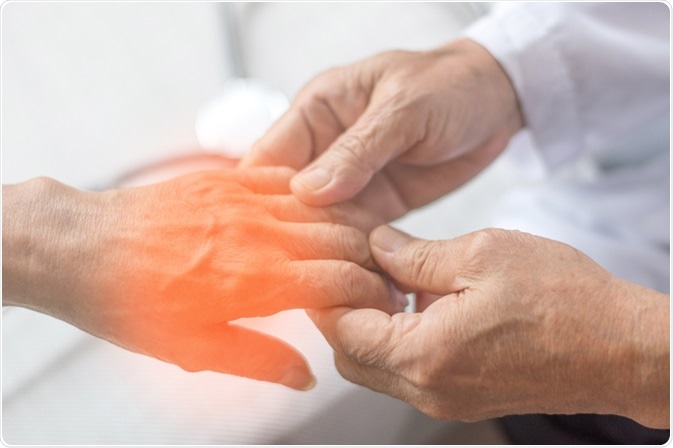Peripheral neuropathy is a condition whereby the nerves of the PNS become damaged.

Image Credit: BlurryMe / Shutterstock.com
What is the PNS?
The peripheral nervous system (PNS) is composed of all the nerves in the body, except for those present in the brain and spinal cord, which make up the central nervous system (CNS). Moreover, the PNS is responsible for sending and receiving neuronal signals to and from the CNS.
There are three types of nerves that make up the PNS, of which include sensory, motor, and autonomic nerves.
The sensory neurons transmit sensations such as heat, pain, vibration, and touch from the body extremities back to the central nervous system. The motor neurons transmit nerve impulses from the brain to the skeletal muscles throughout the body, allowing for movement. Thirdly, the autonomic nerves are responsible for regulating involuntary life-supporting activities such as breathing, heart rate, and digestion.
What is peripheral neuropathy?
Damage to the nerves of the PNS can occur along the axon, which is the elongated stem of the nerve cell, or through removal of the protective myelin sheath that insulates the signal as it progresses along the nerve cell, which is a process know demyelination.
Peripheral nerve damage can stem from inherited or acquired sources. Inherited neuropathies can arise from genetic disorders such as Charcot-Marie-Tooth, which is one of the most common forms of inherited neuropathy. Patients with Charcot-Marie-Tooth disorders have a genetic mutation that results in nerve demyelination and subsequent muscle wasting, lower extremity numbness, and loss of mobility.
Comparatively, acquired neuropathies can result from physical injury or trauma, diseases or medical conditions, or exposure to toxins.
The nerve damage associated with peripheral neuropathy can occur in one nerve, which is known as mononeuropathy, or within many nerves, which is referred to as polyneuropathy. Patients with peripheral neuropathy experience both general symptoms and symptoms specific to the type and number of nerves that are damaged.
General symptoms
The most common symptoms of peripheral neuropathy are numbness, tingling, and prickling sensations, particularly in the hands or feet. Over time, this sensation of numbness can slowly spread up the legs and arms.
Patients can also experience a heightened sense of touch or pain from stimuli that do not normally elicit these sensations. For example, some patients with diabetic neuropathy report that even bed sheets lying over the legs at night can produce severe pain in the feet. In more severe cases of peripheral neuropathy, patients can also experience sharp or burning pain and muscle weakness.
Peripheral neuropathy can exist in chronic or acute forms. In acute neuropathy, for example, the onset of symptoms can appear suddenly and severely, whereas chronic neuropathy will typically cause symptoms to slowly emerge and gradually escalate over months or years.
Specific symptoms
There are three types of nerves that make up the PNS; damage to each type of nerve can produce unique symptoms. For example, when autonomic nerves become damaged, the patient can experience problems with their digestion, bowels, or bladder. Similarly, patients may have trouble regulating body temperature because they are unable to sweat properly. They may also experience changes in blood pressure due to the inability to regulate blood vessel dilation and constriction.
In contrast, motor neuropathy will produce symptoms of muscle weakness, uncontrollable muscle twitching, loss of balance and reflexes, lack of coordination, and even paralysis.
Patients with sensory neuropathy can experience a wide variety of symptoms, depending on whether the damage occurs in the large fibers that detect touch or the small fibers that sense pain and temperature.
Patients with large sensory fiber damage typically experience diminished sensations of touch or a general loss of feeling, while damage to small fibers can prevent a person from detecting pain, which can result in injury or infection. Sensory neuropathy can also cause severe pain.
Mononeuropathy typically limits symptoms to a localized area of the body, while polyneuropathic symptoms can appear on a larger scale.
One of the most common types of mononeuropathy is carpal tunnel syndrome, which is a repetitive motion-induced disorder where inflammation from repetitive stress compresses the nerve and causes pain in the lower forearm.
One of the most prevalent examples of polyneuropathy is diabetic neuropathy, where high glucose levels damage the blood vessels that supply oxygen and nutrients to peripheral nerves. It is estimated that approximately 60% of diabetics experience neuropathic symptoms.
References
Further Reading
Last Updated: Mar 29, 2021